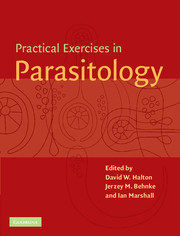Book contents
- Frontmatter
- Contents
- List of contributors
- Preface
- General advice
- 1 Observational Exercises on Parasites
- 2 Ecology
- 3 Physiology and Biochemistry
- 4 Pathology and Immunology
- 4.1 Encapsulation of foreign matter (not-self) by earthworms
- 4.2 Opsonisation of trypanosomes
- 4.3 Production and screening of monoclonal antibodies against Leishmania promastigotes
- 4.4 Pathological effects of Mesocestoides corti and Schistosoma mansoni
- 4.5 Quantification of lymphocyte populations in the spleen and thymus
- 4.6 Use of basic indirect ELISA for the detection of antibodies produced by experimental immunisation
- 4.7 SDS PAGE and Western blotting for the detection of antibodies produced by experimental immunisation
- 5 Chemotherapy
- 6 Molecular Parasitology
- 7 Behaviour
- Appendix 1 Reagent index
- Appendix 2 UK suppliers
- Appendix 3 US suppliers
- Index
4.2 - Opsonisation of trypanosomes
Published online by Cambridge University Press: 05 June 2012
- Frontmatter
- Contents
- List of contributors
- Preface
- General advice
- 1 Observational Exercises on Parasites
- 2 Ecology
- 3 Physiology and Biochemistry
- 4 Pathology and Immunology
- 4.1 Encapsulation of foreign matter (not-self) by earthworms
- 4.2 Opsonisation of trypanosomes
- 4.3 Production and screening of monoclonal antibodies against Leishmania promastigotes
- 4.4 Pathological effects of Mesocestoides corti and Schistosoma mansoni
- 4.5 Quantification of lymphocyte populations in the spleen and thymus
- 4.6 Use of basic indirect ELISA for the detection of antibodies produced by experimental immunisation
- 4.7 SDS PAGE and Western blotting for the detection of antibodies produced by experimental immunisation
- 5 Chemotherapy
- 6 Molecular Parasitology
- 7 Behaviour
- Appendix 1 Reagent index
- Appendix 2 UK suppliers
- Appendix 3 US suppliers
- Index
Summary
Aims and objectives
This exercise is designed to demonstrate:
An important humoral immune killing mechanism against Trypanosoma brucei.
Binding of trypanosomes to macrophages mediated by specific antibodies, the first stage in the process of opsonisation.
Antigenic variation by T. brucei as a mechanism of evasion of specific antibodies.
Introduction
T. brucei is one of three parasite species that collectively cause Nagana, one of the most important diseases of livestock in sub-Saharan Africa. The other two species are T. congolense and T. vivax. There are three sub-species of T. brucei, two of which, T. b. gambiense and T. b. rhodesiense, cause sleeping sickness in humans. Currently, sleeping sickness is predicted to cause 300000–500000 new cases per year. Infection is normally fatal in the absence of chemotherapy but most infected people will have no access to the relevant drugs.
Vaccination is an obvious alternative to reliance on drugs for prevention of infection and/or disease but the development of potential vaccines has been little explored in African trypanosomiasis because these parasites undergo antigenic variation. Each T. brucei parasite is enwrapped in a surface coat that is visible by electron microscopy. The coat is comprised of approximately 107 copies of a single molecular species of glycoprotein. It acts as a physical barrier preventing access to the underlying plasma membrane by components of non-specific immune responses that are lethal to uncoated parasites.
- Type
- Chapter
- Information
- Practical Exercises in Parasitology , pp. 249 - 254Publisher: Cambridge University PressPrint publication year: 2001
- 1
- Cited by



